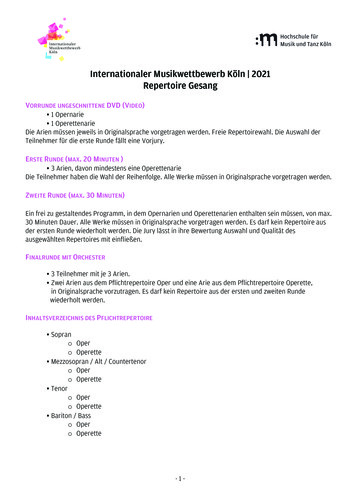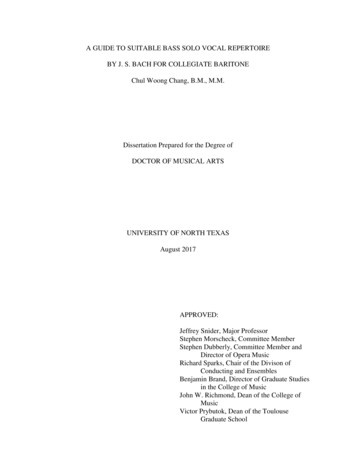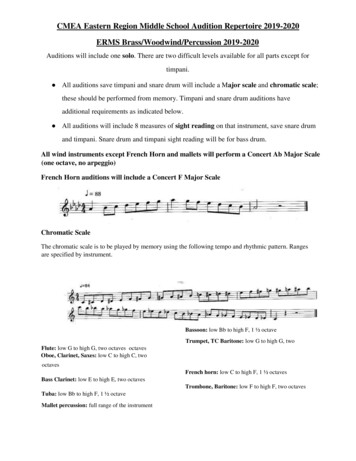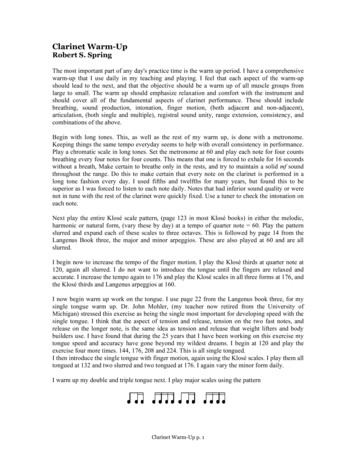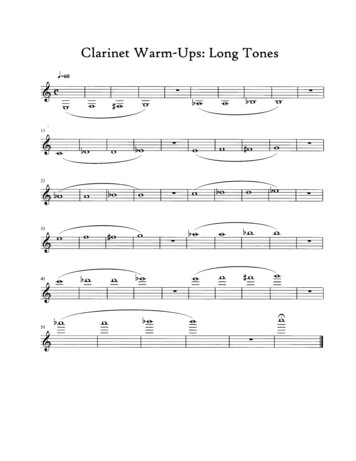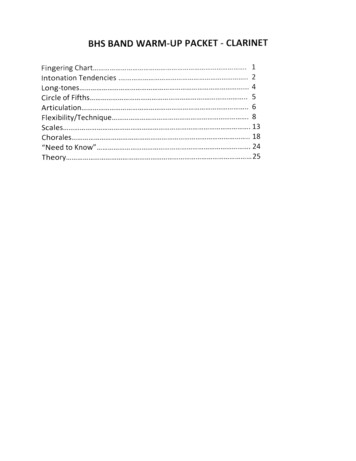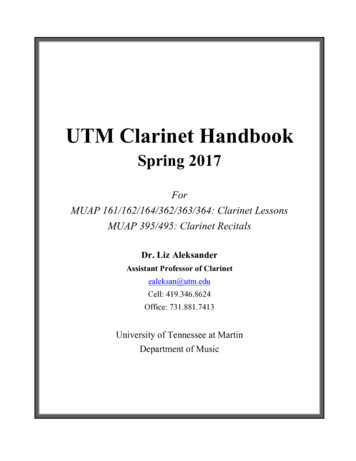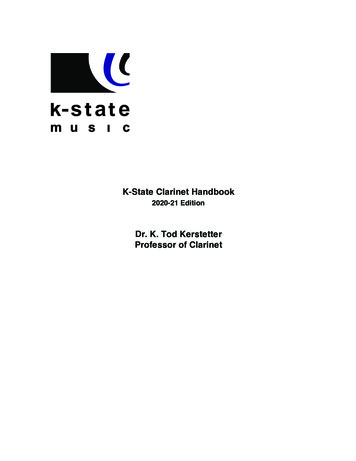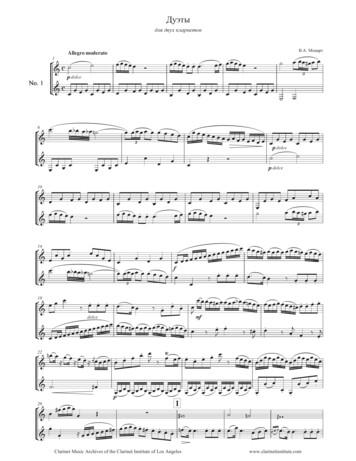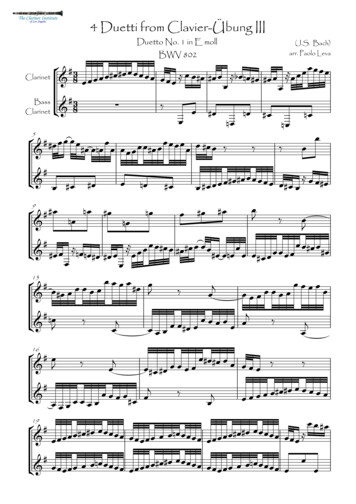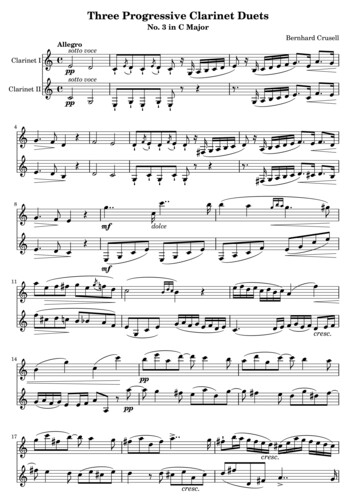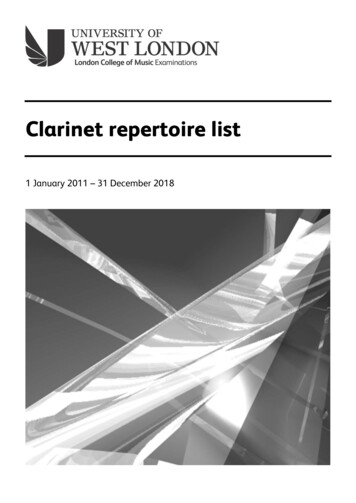
Transcription
Clarinet repertoire list1 January 2011 – 31 December 2018
CLARINETContentsPageIntroduction .3LCM Publications .4Related Examinations .4Examination Formats .5Step 1 .6Step 2 .7Grade 1 .8Grade 2 .10Grade 3 .12Grade 4 .14Grade 5 .16Grade 6 .18Grade 7 .20Grade 8 .22Viva Voce .24Aural Tests .26This repertoire list should be read in conjunction with the current Music GradesSyllabus. Copies are available free of charge via our website,www.uwl.ac.uk/lcmexams, or from the LCM Examinations office.Please refer to the Music Grades Syllabus for full details about graded exams,recital grades, leisure play exams and performance awards.This repertoire list is valid from 1 January 2011 until 31 December 2018.
LCM ExaminationsDirector of ExaminationsJohn Howard BA PhD FRSAChief Examiner in MusicPhilip Aldred BEd FLCMLCM ExaminationsUniversity of West LondonSt Mary’s RoadEalingLondonW5 5RFtel: 44 (0)20 8231 2364email: lcm.exams@uwl.ac.ukwww.uwl.ac.uk/lcmexams Copyright 2011 by the University of West London, LCM ExaminationsSeptember 2013 edition2
IntroductionThis syllabus has been designed to encourage candidates to explore many areas of study, encompassing thetraditions of the Baroque, Classical and Romantic periods. In addition, contemporary works and music in jazzidioms are included.Where indicated, pieces which are supported by a CD backing track can also be performed with anaccompanist, if preferred. It is the candidate’s responsibility to provide suitable audio equipment if CD backingis used. See syllabus regulations.Duets are included in the early stages to encourage the enjoyment of playing music with other people and tohelp develop ensemble awareness. The teacher, another student or a friend could play the lower part, whichwill not be assessed.Pieces in List B should generally be accompanied, unless indicated otherwise.If a piece appears at more than one grade, greater skill levels and interpretation qualities will be expected atthe higher grade.3
LCM PublicationsThe following LCM Publications are relevant to this syllabus: Specimen Clarinet Sight Reading Tests: Grades and Diplomas (LL11881) Specimen Aural Tests (LL189) LCM Aural Handbook: a Practical Guide to Teaching and Preparing for LCM Aural Tests (LL205)LCM Publications are distributed by Music Exchange: tel: 0161 946 9301 email: mail@music-exchange.co.ukA complete list of titles may be found on their website – www.music-exchange.co.ukThe specimen aural tests are also available as downloads from www.LCMEbooks.orgRelated ExaminationsLCM Examinations offers examinations in a wide range of subjects, covering classical, jazz, pop/rock andtraditional music genres. The following syllabuses may also be of interest: Graded, recital grade and leisure play examinations and performance awards for jazz clarinet Performance diplomas (four levels) for clarinet and jazz clarinet Teaching diplomas (three levels) for clarinet and jazz clarinetA flexible Ensemble syllabus is also available, catering for all types of ensemble from duets and trios up toconcert bands and wind bands. Six levels are offered, ranging from Grades 1–2 to DipLCM standard.Syllabuses are available free of charge from the LCM Exams office or from local representatives, or may bedownloaded from the LCM Exams website.AcknowledgementGrateful thanks are due to Stuart Corbett, the principal woodwind syllabus compiler.4
Examination FormatsFollowing is an overview of the four examination formats offered by LCM Examinations: grades, recital grades,leisure play and performance awards. Refer to the relevant section of the Music Grades Syllabus for fulldetails.GradesRecital GradesLeisure PlayPerformanceAwards 3 pieces4 (or 5) pieces,all selected fromrepertoire list4 pieces (3 selectedfrom grade list, plus1 own choice)3 piecesViva Voce Optional forComponent 2 Sight Reading Optional forComponent 2 Aural Tests Grades 1–8Grades 1–8Levels 1–8Levels 1–8 ExaminationExaminationExaminationDVDPass: 65–74%Merit: 75–84%Distinction: 85–00%Pass: 65–74%Merit: 75–84%Distinction: 85–100%Pass: 65–74%Merit: 75–84%Distinction: 85–100%Pass: 65–74%Merit: 75–84%Distinction: 85–100% Technical adingOfqualAccreditation5
Clarinet: Step 1Candidates may use a Bb Clarinet or any suitable beginner instrument, such as the Lyons C Clarinet.The exercises must both be taken from the same book. The pieces may be taken from any of the set books.Some of the pieces and/or exercises are duets. This is to encourage ensemble awareness. The teacher or afriend may wish to play the lower part, which will not be assessed.Component 1 - Exercises25 marksEither: No. 4 and No. 5 (lesson 5A, page 9, slurred notes)A Tune A Day Clarinet(Boston Music/Music Sales)Or:Ex. 1 and Ex. 2 (unit 5, page 14, slurs)Learn As You Play Clarinet(Boosey & Hawkes)Or:Ex. 3 and Ex. 4 (level 1) studiesTeacher On Tap Book 1: Starting Out (Teacher On Tap)Component 2 - Pieces60 marksAny three to be chosen.Twinkle Twinkle Little Star (lesson 5, page 8)The Boat Song (lesson 5, page 8)Lightly Row (lesson 5A)Irish Lullaby (page 8)Oranges and Lemons (page 8)A Little Piece (Schumann) (unit 5)Aria (Gluck) (unit 5)Soka (with CD backing or accompanied)A Tune A Day Clarinet(Boston Music/Music Sales)A Tune A Day Clarinet(Boston Music/Music Sales)A Tune A Day Clarinet(Boston Music/Music Sales)Fifty Five for Fun [solo clarinet](Fentone/De Haske)Fifty Five for Fun [solo clarinet](Fentone/De Haske)Learn As You Play Clarinet(Boosey & Hawkes)Learn As You Play Clarinet(Boosey & Hawkes)Teacher On Tap Book 1: Starting Out(Teacher On Tap)Component 3 - Questions on Rudiments15 marksRecognition/identification of stave, barlines, pitch names, note types and values, rest values, all relating to themusic performed. The importance of looking after the instrument (e.g. keeping the mouthpiece clean, the pullthrough, looking after reeds).6
Clarinet: Step 2Candidates may use a B flat Clarinet or any suitable beginner instrument, such as the Lyons C Clarinet.The exercises must both be taken from the same book. The pieces may be taken from any of the set books.Some of the pieces and/or exercises are duets. This is to encourage ensemble awareness. The teacher or afriend may wish to play the lower part, which will not be assessed.Component 1 - Exercises25 marksScale and arpeggio of G major (tongued and slurred), one octave ascending and descending, from memory[illustrated in Learn As You Play Clarinet, unit 8, page 29]andEither: Ex. 3 and Ex. 8 (lesson 9, pages 14–15) A Tune A Day Clarinet(Boston Music/Music Sales)Or:Ex. 1 and Ex. 2 (unit 7, page 18, B flat) Learn As You Play Clarinet(Boosey & Hawkes)Or:Ex. 8 and Ex. 9 (level 1) studiesTeacher On Tap Book 1: Starting Out(Teacher On Tap)Component 2 - Pieces60 marksAny three to be chosen.Abide With Me (lesson 6, page 11)A Tune A Day Clarinet(Boston Music/Music Sales)Lightly Row (lesson 6, page 11)A Tune A Day Clarinet(Boston Music/Music Sales)Au Clair de la Lune [duet, upper part] (lesson 6) A Tune A Day Clarinet(Boston Music/Music Sales)Johnny Todd (page 14)Fifty Five for Fun [solo clarinet](Fentone/De Haske)Amazing Grace (page 17)Fifty Five for Fun [solo clarinet](Fentone/De Haske)Duo [duet, upper part] (unit 7)Learn As You Play Clarinet(Boosey & Hawkes)Melody in a Phrygian Mode (Bartók)Learn As You Play Clarinet(Boosey & Hawkes)Introducing the Eighth Note (Quaver) (with CD backing or accompanied)Teacher On Tap Book 1: Starting Out(Teacher On Tap)Component 3 - Questions on Rudiments15 marksAs for Step 1, including looking after the instrument, plus dotted note values and knowledge about the purposeof the key signature and time signature, accidentals and basic dynamic signs. All relating to the musicperformed.7
Clarinet: Grade 1Component 1 - Technical Work15 marksCandidates should prepare Option 1 OR Option 2.Option 1: Scales and Arpeggios (ascending and descending from memory)(suggested tempo: m.m. crotchet 60 when played in quavers)to be played tongued and slurred:G and F major (one octave); A minor (one octave) [harmonic OR melodic minor scale, at candidate’s choice]Option 2: Scale and StudyScale: G major (requirements as for Option 1)Study: The Middle Man (p5) from 38 More Modern Studies for Clarinet (Rae)Component 2 - Performance(Universal 21554)60 marksPerformance of three pieces: one piece from List A, one piece from List B, one piece from either List A or List B.There should be evidence of contrast in the programme.LIST ERCIVALRAERAERAERAEREYNOLDSNo. 2 OR No. 3 OR No. 4 (p3) from Elementary School for Clarinet(Peters)Aria (p15) from Learn As You Play Clarinet(Boosey & Hawkes)Frog Hop OR First Base from Cool School (Clarinet)(Brass Wind)Russian Dance from Winners Galore (Clarinet)(Brass Wind)I Had a Little Dove OR Lady Owen’s Delight OR Cantilena Song from Studies for Clarinet(ABRSM)No. 4 from Clarinet Studies(Useful Music U30)A Small Step OR Coo’s Blues OR Ready Aim Fire from Easy Jazzy ‘Tudes(Warwick Music)Ex. 4 OR Ex. 5 OR Ex. 6 (Level 2) studies from Teacher On Tap Book 1: Starting Out(Teacher On Tap)Proclamation OR First Waltz from Style Workout for Solo Clarinet(Universal)Spiritual OR Diggin' Deep (Lesson 10, p29) from Introducing the Clarinet(Universal 165851)The Middle Man from 38 More Modern Studies for Clarinet [if not played in Component1](Universal 21554)Undercover (No. 2) OR Backtrack (No. 5) from 40 Modern Studies for Solo Clarinet(Universal)March OR Moderato from The Clarinettist’s Progress Book 1(Hunt Edition)LIST ORTONNORTONRollerblading from Step It UpAutumn Leaves from First Recital SeriesChorus from Paris and Helen from Learn As You Play ClarinetActivate OR Spirals from Upbeat! for Clarinet Book 1Reflections from First Recital SeriesMarch from Music Through Time for Clarinet Book 1 (Harris)Nutty Flavour OR Miss P Dolce from New Clarinet Solos Book 1Promises from Microjazz Collection Book 2Soldier Boy OR Under A Cloud from Microjazz Collection Book 18(Faber)(Curnow)(Boosey & Hawkes)(Music Exchange)(Curnow)(OUP)(Useful Music)(Boosey & Hawkes)(Boosey & Hawkes)
AD.TRAD.Nashville Express OR Valse Veird from Teacher On Tap Book 1: Starting Out(Teacher On Tap)Rigaudon from Ten Easy Tunes for Clarinet (arr. Griffiths)(Fentone/De Haske)Song from Music Through Time for Clarinet Book 1 (Harris)(OUP)Miss Natalie OR Evening Breeze from Latin Clarinet(Universal)Romance from First Book of Clarinet Solos(Faber)Humming Song from Learn As You Play Clarinet(Boosey & Hawkes)Kalinka from Ten Easy Tunes for Clarinet (arr. Griffiths)(Fentone/De Haske)Riddle Song from The Joy of Clarinet(Yorktown / Music Sales)Riding On A Donkey OR Hatikvah OR Pierrot from First Book of Clarinet Solos(Faber)Shepherd’s Hey from First Book of Clarinet Solos(Faber)Component 3 - Viva Voce7 marksSee pages 24–25.Component 4 - Sight Reading10 marksUp to one minute’s preparation time will be allowed to study the test before playing, during which the candidatemay try parts of the test if they wish. Specimen tests are available (LL11881).Component 5 - Aural Tests8 marksSee pages 26–30. Specimen tests and a handbook are available (details on page 4).9
Clarinet: Grade 2Component 1 - Technical Work15 marksCandidates should prepare Option 1 OR Option 2.Option 1: Scales and Arpeggios (ascending and descending from memory)(suggested tempo: m.m. crotchet 60 when played in quavers)to be played tongued and slurred:G and F major (two octaves)C major (one octave)A and D minor (one octave) [harmonic OR melodic minor scale, at candidate’s choice]Option 2: Scale and StudyScale: C major (requirements as for Option 1)Study: Staccato Dance (p8) from 38 More Modern Studies for Clarinet (Rae)Component 2 - Performance(Universal 21554)60 marksPerformance of three pieces: one piece from List A, one piece from List B, one piece from either List A or List B.There should be evidence of contrast in the programme.LIST NGALEPERCIVALRAERAERAERAEREYNOLDSNo. 5 OR No. 6 OR No. 7 (p4) from Elementary School for Clarinet(Peters Edition P2417)March from Starters for Clarinet (arr. Lewin)(ABRSM)Tongue and Groove from
Duets are included in the early stages to encourage the enjoyment of playing music with other people and to help develop ensemble awareness. The teacher, another student or a friend could play the lower part, which will not be assessed. Pieces in List B should generally be accompanied, unless indicated otherwise. If a piece appears at more than one grade, greater skill levels and .
